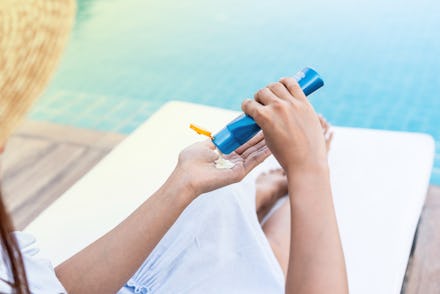Yes, you can be allergic to sunscreen. Here's how to tell

As the days heat up, Hot Vax Summer is beckoning us to sprawl out with our friends by the pool, on the lawn, and wherever else we used to gather in the Before Time. But if we don’t want these long-awaited reunions leaving us with lovely, lobster-hued sunburns — which, yes, even the darker-skinned among us are susceptible to — not to mention a higher risk of skin cancer, then we’ll need to slather on the SPF. Not everyone can rely on this standard form of protection, though, specifically people who have a sunscreen allergy. Yes, you can be allergic to sunscreen.
To get a better handle on this phenomenon, I spoke with Cindy Wassef, assistant professor at the Center for Dermatology at Rutgers Robert Wood Johnson Medical School. Wassef broke down how to know whether you’re allergic to sunscreen and if so, what to do about it.
What is a sunscreen allergy, anyway?
A sunscreen allergy typically appears as an itchy and/or painful rash or hives, Wassef tells me. It can be triggered by either merely applying the sunscreen itself in a reaction known as allergic contact dermatitis, or applying it and staying out in the sun in a reaction known as photocontact dermatitis. In the case of allergic contact dermatitis, you might notice a rash within 1 to 3 days of putting on the sunscreen, but over time it may show up more quickly. If you have photocontact dermatitis, you’ll likely notice a rash within 1 to 3 days of wearing it in the sun. A host of ingredients can cause it, but the preservatives and fragrances — not necessarily the active ingredients that offer protection — are “by far the most common,” Wassef says.
The good news is that sunscreens are more likely to cause irritation, a.k.a. irritant contact dermatitis, than a true allergy, she explains. It looks similar but takes less time to surface, usually within a few hours.
What can I do if I think I’m allergic to my sunscreen?
If you start noticing symptoms, try applying 1% hydrocortisone cream or ointment to the affected area, Wassef says. If that doesn’t help, she suggests seeing a dermatologist, who might prescribe you a stronger steroid or other medications that can provide relief.
If you’re using a chemical sunscreen, try swapping it out for a zinc- or titanium-based mineral one, Wassef says, which is less likely to trigger a reaction. For those unfamiliar, chemical sunscreens contain ingredients like octocrylene or oxybenzone that get absorbed into the skin, protecting it from UV rays, she explains. She notes that "oxybenzone has been one that people have had allergies to."
Mineral sunscreens — which typically contain zinc oxide or titanium dioxide — work by scattering light, essentially creating “a shield on your skin, so they’re not absorbed as much, and that’s why you don’t see allergies to them that often.”
Make the same switch if you think your sunscreen is causing irritation, but not a full-on allergy. Less absorption also means less irritation, Wassef says. “The downside is [mineral sunscreens] can leave a white or grey hue to the skin because they don’t rub in as well.”
How can I confirm whether I have a sunscreen allergy?
“That tends to be hard to do independently,” Wassef says. She recommends making an appointment with a dermatologist or allergist for a patch test, which screens for sensitivity to a broad array of possible culprits, including specific ingredients — like fragrance mixes and preservatives — as well as the sunscreens themselves. Basically, the doctor will put small amounts of these allergens on your skin and cover each with a patch.
“It doesn’t hurt at all,” Wassef says. “They leave [the patches] on for a few days, take them off, and then give your skin time to see if you mount any type of allergic response,” with the entire process taking roughly a week. If you develop a rash under a patch, that probably means you’re allergic to whatever substance your doctor applied beneath it, she explains.
What can increase my risk of a sunscreen allergy?
If you have eczema, you’re at a higher risk of allergic contact dermatitis to sunscreen and skin creams in general, Wassef says. She adds that if you have a condition associated with highly sensitive skin, like rosacea, sunscreen may cause irritation rather than a full-on allergy.
When should I seek immediate medical attention?
In very rare cases, Wassef says, putting on sunscreen can trigger an allergic reaction not only on your skin but elsewhere in your body. She recommends seeking urgent care in an ER-type setting if you experience shortness of breath, nausea, or vomiting. The same applies if you have a fever, chills, or any other signs of infection, which can happen if, say, you’ve scratched the affected area a ton and broken skin.
If I’m allergic to sunscreen, what other options do I have for sun protection?
If you do a patch test and identify the ingredients to blame, you could opt for sunscreen that doesn't contain them. But if you want to use something besides sunscreen, Wassef points out that you can look into sun protective clothing, which uses what’s known as a UPF rating system, similar to SPF. Wearing a shirt with a UPF of 40 is like putting on an SPF 40 sunscreen, she says, and explains that “it has to really do with how the fabric is woven, so any areas that are covered, you are getting that protection.” She also points to more classic forms of protection, like seeking shade and avoiding the sun when it’s hottest — between 10 a.m. and 2 p.m.
A sunscreen allergy can be annoying and uncomfortable, but thankfully, you can work around it so that you can enjoy your post-vax summer shenanigans while still getting the protection you need.